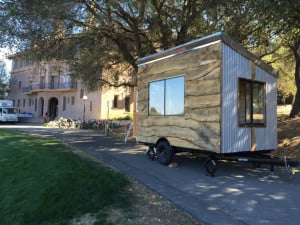
A team of Stanford students built a small, portable arts studio using materials found at Jasper Ridge over the summer as part of an Arts Intensive. The studio has the potential to be a new, separate arts space to which student artists can retreat to create art. The students propose keeping it on campus during the fall and winter quarters and moving it to the Jasper Ridge Biological Preserve for spring and summer quarters.
From Aug. 30 to Sept. 18, a group of students in the “Tiny Eco Houses for Artists: Social Practice, Design/Build” arts intensive built Studio 2, which is currently sitting unused at the Jasper Ridge Biological Preserve. Because portable art studios allow artists to create art in an inviting and productive environment, the students in the art intensive have proposed that their creation be brought onto campus – potentially near the McMurtry building – not only to aid artists but also to promote awareness of the Jasper Ridge’s presence.
“I think there’s a lot of power in just having a space for you to use to create art. Versus you’re in your dorm room, and your roommate’s there, and there are people running around the halls,” said Kevin Zhai ’16, an art studio major involved in the project. “There’s a power to physically moving to another space and having the mindset that I’m going to go to work now.”
However, Zhai stated that there still exist lots of “red tape” and hurdles to bringing the studio back onto campus. Philippe Cohen, the executive director of the Jasper Ridge Biological Preserve, is optimistic that the students’ goal to move the studio will be achieved.
Though the studio is functional, it is nowhere near finished. Zhai speculates that volunteers will be needed in order to finish the studio, but he hopes that the proposal will be successful and that the Stanford community will soon see Studio 2 on campus.
How the project was born
David Szlasa, a local artist who built the first studio, Studio 1, guided the team. He originally built Studio 1 and parked it in his driveway as his home workspace. However, Szlasa soon realized the larger potential of spaces like Studio 1, especially due to the dearth of affordable studio space in the Bay Area. Studio 1 was then invited to art festivals as an example of alternate space solutions.
“Their portability allows them to be an agile arts platform,” said David Szlasa on the benefits of small art studios. “They both can be flexible where they’re deployed, but then they can also move and refresh themselves to re-inspire artists or for the organization that’s hosting the studio to reach new audiences. It keeps them fresh and funky.”
As Studio 1 garnered more publicity, it caught the eye of Sarah Curran, programming director of the Stanford Arts Institute, and Cohen, who wanted to host more than just the sciences at Jasper Ridge.
After numerous meetings, Curran and Cohen decided to create a new arts intensive led by Szlasa at Stanford. Interested in the tiny houses movement, Zhai signed up for the course.
“Day 1 was basically just a trailer bed and that was it,” Zhai said. “So on Day 1, we started building the subfloor, started doing measurements for the walls and floors and stuff like that. By the end of the arts intensive three weeks in, it was pretty much done: The floors were in, the walls were all up, the roof was on, the solar panels were installed. A couple of the kids were also building a bench and a little fold-out table.”
Looking to the future
Complaints started arising as the students began to sense the uncertainty of the studio’s future on campus. Students in the arts intensive penned a proposal to Curran, Cohen, Szlasa and others suggesting that Studio 2 remain on campus for fall and winter quarters so that students could have easy access to the studio.
The students also requested that the studio be returned to Jasper Ridge in the spring and summer, so students who had classes at the Preserve could be exposed to the studio as well. The only exception would be during Admit Weekend. The students wanted the studio back on campus so high school students interested in the art scene at Stanford could explore the studio and understand the plethora of opportunities for student art spaces and initiatives on campus.
“Artists could work in it, but then you could also open the doors and show people what you’ve been working on,” Zhai said. “I think we’re definitely drawing upon David Szlasa’s original intention as well where just having a studio on campus will start conversation and make people more aware of things.”
Contact Anne-Marie Hwang at amhwang ‘at’ stanford.edu.
